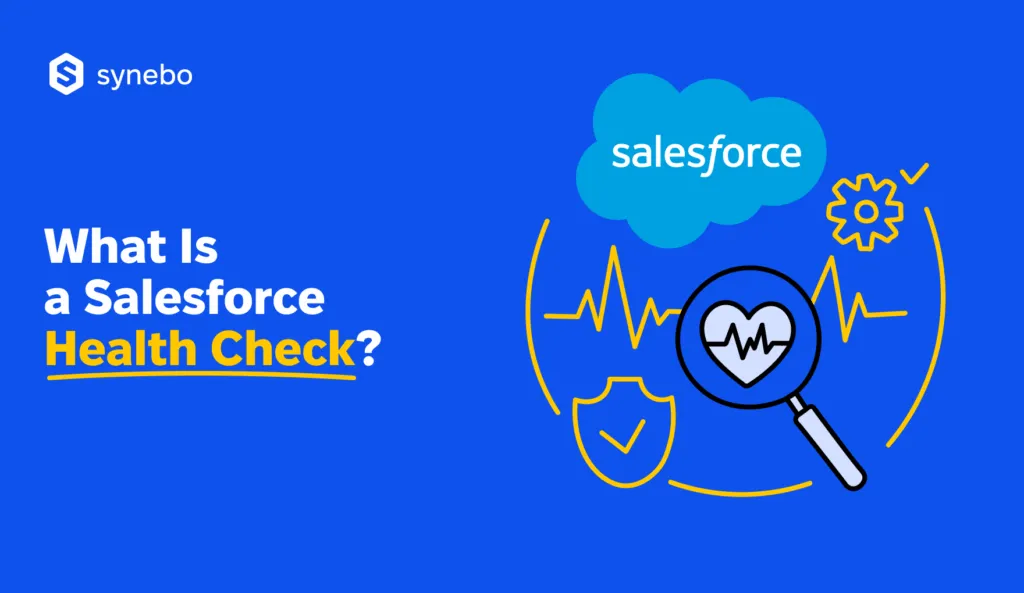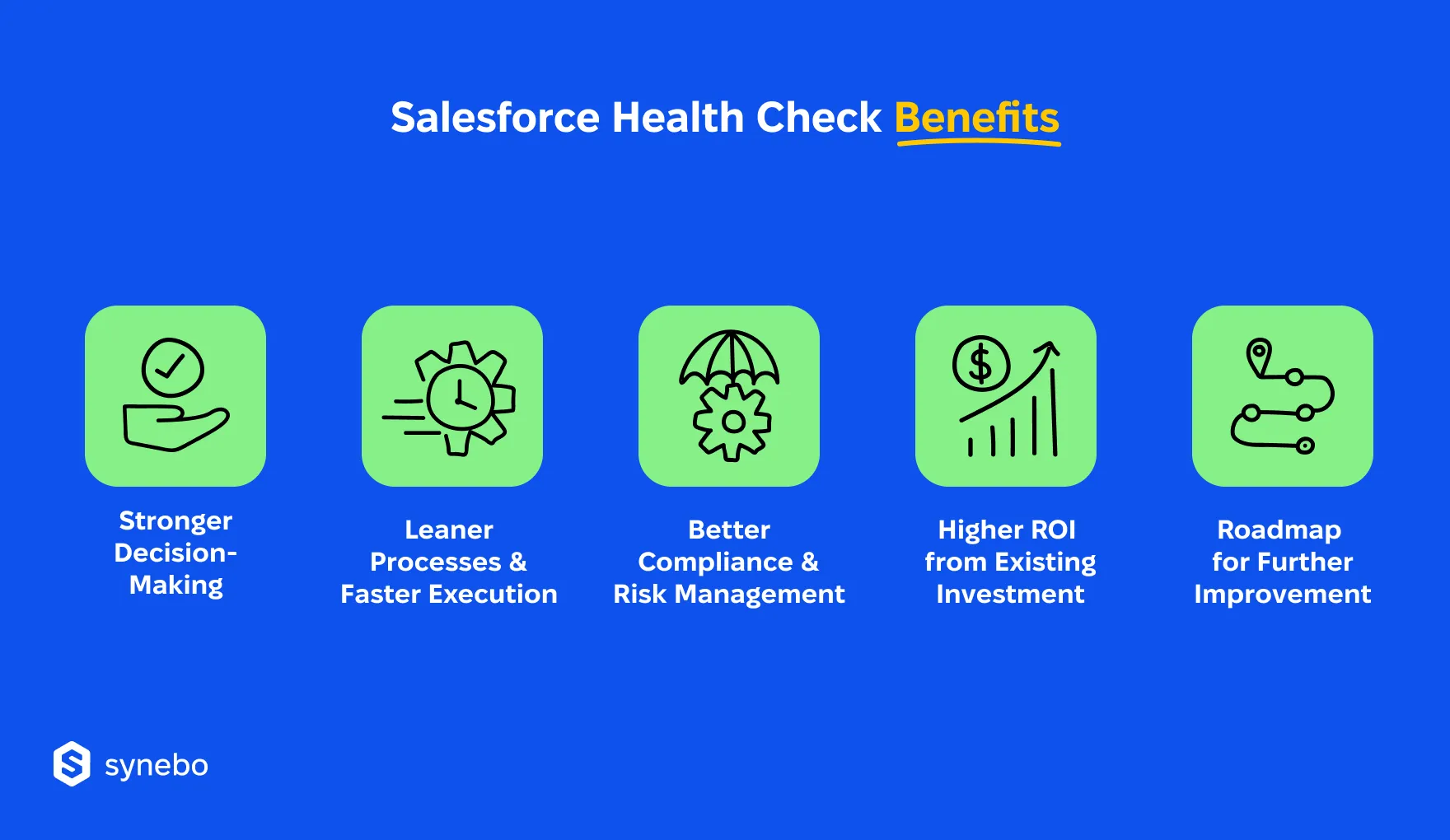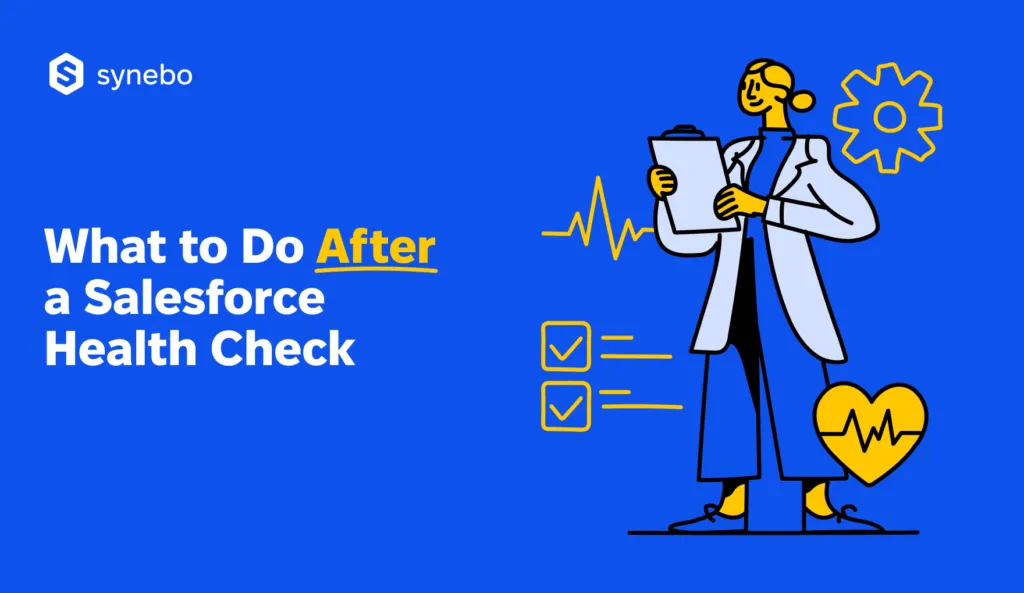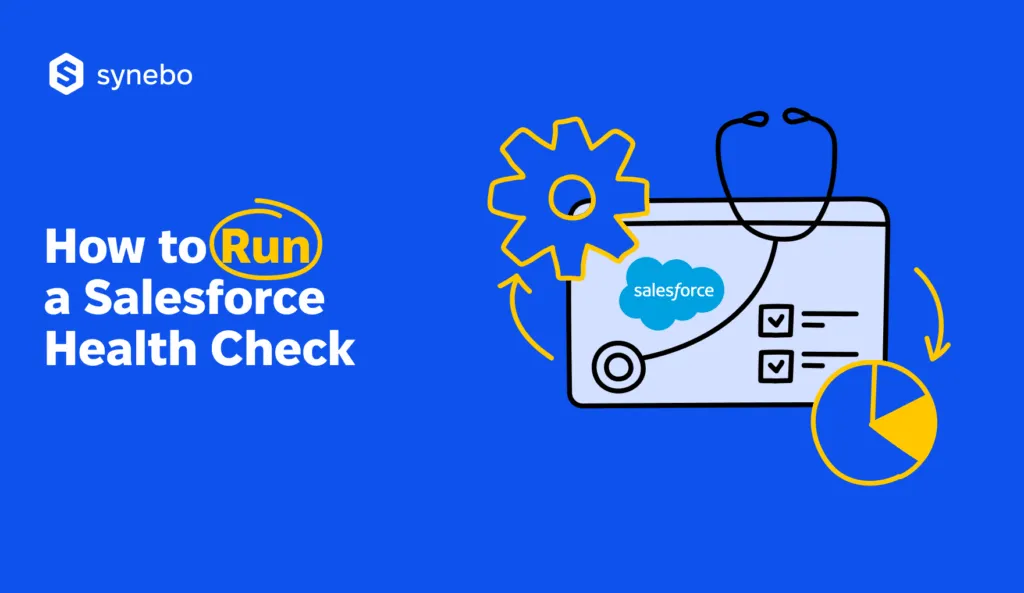What Is a Salesforce Health Check and Why Your Org Needs One?

Your CRM may “pulse” with data. Yet, if we keep to medical terms, when its “heartbeat” weakens, irregularities creep in: gaps in info, overlooked settings, or permissions that no one notices at first. Salesforce health check works like a thorough medical examination for your system. It spots those hidden flaws before they grow into costly problems.
We’ve regularly seen how seemingly stable Salesforce orgs quietly hide misconfigurations, tangled integrations, or data inconsistencies, and those erode efficiency. These irregularities chip away at user confidence and, over time, at revenue.
Figures say that companies earn an average of almost $9 for every dollar invested in CRM implementation – when it operates effectively. At the same time, nearly half of sales leaders (48%) admit their CRM underperforms. It lacks automation, suffers from poor configuration, or mishandles data in ways that prevent it from delivering the expected results.
As efficiency slips, the true value of your investment diminishes, too, significantly reducing the return on every dollar you’ve put into your CRM.
In this article, you’ll find a roadmap to understanding the Salesforce system health check: what it examines, why timing matters, and how acting early contributes to your company’s agility, and growth.
What Salesforce Health Check Reveals
Health check in Salesforce is a thorough scan that spots security weak points, misconfigurations, and inefficiencies before they turn into lost deals, data breaches, compliance trouble, or frustrated users in your team.
SF offers a dedicated dashboard for such scanning – a built-in command center where you can see your org’s security score (from 0 to 100) and review prioritized recommendations.
A full Salesforce org health assessment unfolds in 3 key directions:
- Pinpointing Vulnerabilities. It highlights open sharing settings, weak password policies, outdated authentication methods, or overly broad profiles that invite unnecessary risk.
- Revealing Performance Hitches. It identifies redundant workflows, orphaned triggers, overloaded automation, or fields that drag load times and slow everyday processes.
- Delivering Insights You Сan Follow. Instead of merely flagging problems, it provides clear steps that you can rely on to refine security, simplify rules, plus speed up your system responsiveness.
For example, your Salesforce health check score can show faulty access settings cause nearly 30% of SF breaches. It’s a stark warning that you must pay attention to it now and spare your company org a more costly incident and reputational harm.
So, regardless of what you oversee – operations, technology, or broader business direction – a Salesforce org health check gives you visibility into how your CRM behaves. It brings back trust in your data, strengthens defenses, and raises performance levels.
The sections below will break all of this down in greater detail.
Does a Salesforce Health Check Pay Off?
Perhaps, you’ve never run any check. Perhaps, you are unsure it’s worth your effort. Or maybe it’s been sitting low on your to-do list for months. Still, treating such check-ups as a regular practice – this simple habit – keeps your SF environment productive, reliable, and ready to support your business growth. It shows what’s critical, what’s outdated, and what costs you more than you realise.
Let’s figure out what consistent Salesforce org assessments deliver.

Your Decision-Making Becomes Stronger
When your SF data is inconsistent, outdated, or incomplete, your every strategic move rests on shaky ground. A health сheck reviews configuration, integrations, and data quality so all your decision-makers can trust their reports without cross-verifying in spreadsheets.
Practically speaking, you enjoy faster approvals, sharper forecasting, and a smaller gap between data and action. Hence, shorter period between idea and execution – see the next point.
You Enjoy Leaner Processes and Faster Delivery
Custom workflows, unused objects, and duplicate automations accumulate over time like clutter in a warehouse. They slow down user adoption, frustrate staff, and eat away at your business productivity. A thorough Salesforce health check assessment rethinks automation logic, removes the dead weight, and equips your people with a cleaner, more responsive environment to work in.
Practically speaking, you unlock faster workflows, accelerate deliveries of your projects, and reduce your wasted effort. Your team can seize opportunities faster – before competitors do.
You Get Better Соmрlіаnсе and Risk Management
It’s one of the undeniable benefits of Salesforce health check, especially in the regulated sectors (fintech, healthcare, and more). For them, non-compliance implies a serious financial and reputational risk.
An SF health check uncovers gaps in permissions, audit trails, and security settings that could leave critical information exposed. Addressing these findings reduces the chance of breaches or failed audits and turns compliance into a routine.
Practically speaking, a Salesforce security health check gives you confidence that your org meets regulatory policies, you avoid costly penalties, and all the audits become painless. Your team operates without second-guessing if data or processes meet standards.
ROI from Your Existing Investment Gets Higher
You’ve already paid for Salesforce. But are you using all the features you’re licensed for? Our experience shows that many companies leave advanced functionality untouched (due to a lack of awareness or poor configuration). A Salesforce health check audit reveals underused tools that could replace costly third-party solutions, cut license waste, and maximise the value you’re already paying for.
Practically speaking, you reduce unnecessary software costs, get more from the licenses you’ve already purchased, and free your staff from juggling redundant tools.
You Gаіn an Impulse for Continuous Іmрrovement
You don’t react to user complaints or firefight urgent issues anymore (or these are noticeably diminished) – you get a plan to act. A health inspection doesn’t just flag problems. In the Salesforce health check report, you see those problems marked by business impact.
Practically speaking, you know exactly which fixes will deliver the biggest business payoff and can implement them before they develop into expensive issues.
Salesforce specialists from Synebo can supervise your system health assessment, pinpoint improvements critical for your business, and turn the findings into a concrete plan that keeps your org efficient. Contact us.
Inside a Salesforce Health Check: What Gets Inspected
A tricky question: Do you think your Salesforce org is running exactly as you set it up 2 years ago? Actually, configurations drift, quick fixes pile up, and “temporary” workarounds turn into permanent structures nobody dares to touch.
Let’s unpack what is inspected when you start a health сheck and why each area holds significance.
1. System Security & Rights
Who has access, where, and what can they do with it? As time passes, permission sets and profiles often become tangled.
A health check for Salesforce maps these settings, flags:
- Excessive access
- Outdated user roles
- Inconsistencies that leave sensitive data exposed
You get a good baseline for better control, and your legitimate work isn’t slowed down.
2. Data Quality and Structure
If it’s not obvious, believe our hands-on experience: “dirty” data is expensive. Records that duplicate, missing fields, and different – inconsistent – formats undermine trust in reports.
A health check in Salesforce examines:
- How information enters your system
- How it’s validated
- Where any breakdowns occur
This inspection helps you fix structural flaws and create a more reliable system of records/data.
3. Configuration and Customisation Review
You always get new projects. And with those, workflows, page layouts, validation rules, scripts for automation, so on – evolve, too. Yet, without periodic review, unused or conflicting configs clog your system.
The Salesforce org health check identifies:
- Redundancies
- Conflicting triggers
- Outdated custom objects and more
This allows you to simplify your setup and not lose its capabilities.
4. Integration Health
Most SF environments don’t work alone – they connect to other platforms (ERP, marketing tools, portals for customers, and more).
However:
- Integrations age
- APIs change
- Data sync errors gradually creep in
The Salesforce org health-check assessment tests these connections, highlights failures or inefficient syncs that hurt your operational flow.
Read Also: Best Practices For Salesforce Integration With Third-Party Apps
5. System Performance
If your users complain that “Salesforce works or feels slow,” the cause may not be obvious. Your IT crew may try to find out, but fails – everything seems to be working.
As the Salesforce health check process unfolds, it:
- Measures response times
- Identifies automations that eat up the system resources
- Highlights areas where performance tuning can shave seconds off every interaction
Those seconds add up quickly in the daily workload of a busy sales or service team. After the check, you know exactly which processes or areas to address.
A Salesforce health check, if you treat it as a periodic audit, keeps your system agile, secure, and efficient. Methodical review of these core areas we outlined above helps you get a clear understanding of your setup and give you a plan to ensure your CRM supports your business growth instead of quietly holding it back.
Why a One-Off Health Check Isn’t Enough
You may probably remember the tricky question above. Here we’ll provide a clearer answer: your Salesforce org today isn’t the same as it was even 6 months ago.
New integrations, extra features, and quick fixes have quietly changed its shape. Those changes are necessary – they fuel your growth. But they also bring hidden complexity and fresh risks. A one-time inspection may solve today’s problems, but it won’t protect you from the ones that will arrive tomorrow.
Below we’ve given 4 main reasons why regular Salesforce health checks and optimization are essential.

Reason 1. Security Threats Don’t Stand Still
Cybersecurity risks evolve faster than most people and companies can track. A permission model that felt super-protected last year may now leave doors open for malicious access. Regular Salesforce health check services evaluate your org’s security state, find gaps before they’re exploited, and keep protective measures responsive to the existing risks.
Reason 2. Complexity Builds with Every Enhancement
Each new workflow, automation, or integration extends your setup – it’s true. Yet, each also increases the number of moving parts. After a while, that complexity can create friction. You start feeling that processes are slowed, some conflicts are emerging, and people that use the system are confused.
Recurring SF health inspections keep that growth in check, prune outdated components and streamline where possible.
Reason 3. You Stay in Step with Recommended Practices and Regulations
Regulatory frameworks shift. SF itself releases new capabilities. Industry standards change, too. Without periodic review, your Salesforce org risks drifting away from compliance demands and platform best practices. Its regular assessment acts as a course correction and lets your configs remain ready for audits and fully in line with SF’s latest architecture guidelines.
Reason 4. You Are Prepared for Scalability and Updates
Your business never stays static, and neither do your CRM goals and expectations. If your org is already bloated with legacy configurations, a major platform update or rapid scale-up can become an expensive undertaking. Frequent Salesforce system health checks maintain a well-structured system, so when you scale and adopt new features, it feels quite natural.
Hard to figure out on your own how to carry out a proper health check? Reach out for Salesforce health check services from Synebo. Our experts will trace subtle shifts in your setup, expose silent troublemakers, and fine-tune your CRM so it’s synchronized with your ambition.
Your CRM Says “Check Me” if…
A Salesforce org rarely falls apart overnight. The warning signs usually creep in and pile quietly. And only after a certain while (you can never say exactly how long) you may clearly feel that efficiency dipped, adoption dropped, or/and reports no longer tell the full truth.
How does your CRM signal “Salesforce health issues”?
You can run through these checkboxes and mark anything you may already be noticing.
☐ Pages are loading slower than they used to
☐ Users regularly report errors or access problems, it leads to poor adoption
☐ You see duplicate, incomplete, or inconsistent records
☐ New integrations or SF updates were added without a post-change review
☐ You have no certainty about who can access sensitive data
☐ Your setup has overly complex customisations that no one fully understands anymore
☐ Some features sit unused or are no longer working
☐ You struggle to stay compliant with regulations
☐ You had no formal system review in the last 6–12 months
Have you spotted more than a couple? Well, your CRM is overdue for a check-up.
Before Small Salesforce Health Issues Become Big Problems
So, SF rarely fails in one dramatic moment. Yet, by the time the warning signs we’ve mentioned above are obvious, the fix is no longer quick or cheap. Alas. A regular Salesforce health check audit is a safeguard for your CRM’s reliability, security, and ability to scale.
Our team has spent years dissecting SF orgs, spotting risks early, and turning scattered systems into well-oiled environments.
Are you facing issues with your SF? Don’t know how to start? Want certainty instead of frustration about what’s going on with your system? Get your SF health check with a Salesforce specialist from Synebo. Let’s find the gaps and fix them fast.
It’s a structured “examination” of your SF setup – security, quality and integrity of data, your customisations and integrations, plus performance of your system. It’s a technical audit that exposes inefficiencies and risks before they hurt your business. As a result of such an audit you get а Salesforce health check report with insights that help your org become faster, safer, and easier to scale.
1-2 times a year works for most organisations. If your system undergoes frequent changes – like new integrations or significant team shifts, quarterly reviews are safer. SF evolves rapidly and noticeably, so periodic reviews make you certain your config, security, and processes stay current.
Depending on complexity, you can expect any period from less than one day for smaller, straightforward setups to a week (or even weeks) – for large, heavily customised environments. In the Salesforce health check process, the focus is on accuracy. Skipping details often means bigger issues after a while.
No. It’s a read-only process. The assessment reviews settings, security measures, and system performance without making any changes or interrupting your user activities. While the evaluation process takes place in the background, your people can keep working as usual.
No. You’ll need admin rights – or to work with a certified Salesforce specialist who has them. Without access to all settings, any review would be incomplete. It will leave blind spots that may hide serious risks.












